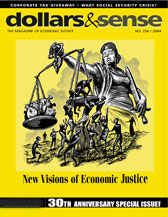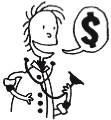This article is from the November/December 2004 issue of Dollars and Sense: The Magazine of Economic Justice available at http://www.dollarsandsense.org

This article is from the November/December 2004 issue of Dollars & Sense magazine.
Subscribe Now
at a discount.

Dear Dr. Dollar:
What is the difference between how a “radical” or “progressive” economist and a “liberal” economist looks at things? It seems like there are plenty of liberal economists around today who are critical of the administrationís economic policies.
—Loren Rodgers, Watertown, Mass.
In the early 19th century, as capitalist industrialization transformed Western European society, both advocates and critics of the emerging social order discussed it in similar terms. To early commentators, society was divided into broad social classes—landlords, laborers, capitalists—defined by their power over economic resources. Analyzing this new capitalist system entailed understanding the creation and distribution of the social surplus—production beyond what was necessary to feed and house the workers—since this surplus provided rents and profits for the non-laboring classes.
By mid-century, thinkers like Karl Marx had turned this language into a powerful critique of capitalism. Marx argued that the politically disenfranchised working classes were victimized in industrial factories, the fruits of their labor stolen and transformed into profits with which the capitalist class created ever-more powerful tools of exploitation. Socialist, communist, and other radical movements demanded political and economic change, some calling for revolution and an end to private ownership of the means of production.
Partly in reaction to this, a very different language for talking about capitalist economies emerged by the turn of the 20th century. Called “neo-classical economics,” it was quickly adopted by universities as the foundation for a new “economic science.” The neo-classicals jettisoned “classical” concerns with social class and control over resources. In their framework, society was simply a collection of self-interested individuals, all competing to maximize their own economic gains. The neo-classical world was a world devoid of history, politics, institutions, or any power, save for the coercive power of governments.
In this world, competitive markets were not the product of history, shaped by concrete political actions, but rather the natural form of economic organization and one to which all nations should aspire. In competitive markets, free individuals could work or reject work, buy or decline buying. Exploitation was ruled out by definition. If you work for $5 a day, that is your decision. You could just as easily choose to hold out for a higher wage or not to work at all.
This neo-classical paradigm continues to dominate the economics profession. What critics today call “mainstream” or “orthodox” economics (what most professional economists call simply “economics”) embodies the core ideas laid out more than a century ago. All analysis begins with the assumption that economic decisions reflect individual preferences and free choice. Pick up an economics textbook today and flip to the chapter on “consumer behavior” and find virtually no mention of advertising. Flip to international economics and search in vain for discussion of transnational corporations and corporate power. Companies large and small are merely “firms,” WalMart and the local grocer equal competitors for consumer dollars. Workers are merely a subset of consumers, “endowed” with “human capital” which they may or may not choose to rent out for wages in the marketplace.
This language of free choice and individualism tends to support conservative economic policy, and is rarely challenged, even by those who identify as liberals. Not that mainstream economics is completely uncritical of markets. Joseph Stiglitz, for example, won a Nobel prize for theoretical models demonstrating that markets will be “inefficient” if parties lack complete information (if a firm knows its books are cooked, but the bank does not, for example). Paul Krugman was acclaimed in part for his work on inefficiencies caused by speculators in international currency markets.
To reject the core assumptions of individualism and free choice, however, is to place oneself “out of the mainstream.” Though a good number of economists fall into this category, many would be uncomfortable with the tag “radical.” Others call themselves “heterodox,” “progressive,” “feminist,” “institutionalist,” “post-Keynesian,” “Marxist,” “social economists,” or “ecological economists.” Like the American left in general, these groups differ in focus and politics. What most share is an insistence that economic analysis address structural power and the inequities of race, class, and gender. Most are also concerned with the destructive impact of markets on environmental and social stability. And most see themselves as part of a centuries-old tradition of political economy that does not divorce economic questions from social and political ones.
As the political center of gravity in the United States shifts rightward, prominent liberals have grown increasingly critical of right-wing economic policies. After stints in the Clinton administration and at the World Bank, Stiglitz wrote two books attacking the political power of the finance industry. Krugman became the bÍte noir of the Republican right once he began writing op-ed columns for the New York Times. For those shunted “out of the mainstream,” such dissidence is a hopeful development. But we must also remember that mainstream economics has absorbed and even celebrated dissidents in the past, without abandoning its allegiance to the neo-classical framework.
Did you find this article useful? Please consider supporting our work by donating or subscribing.
